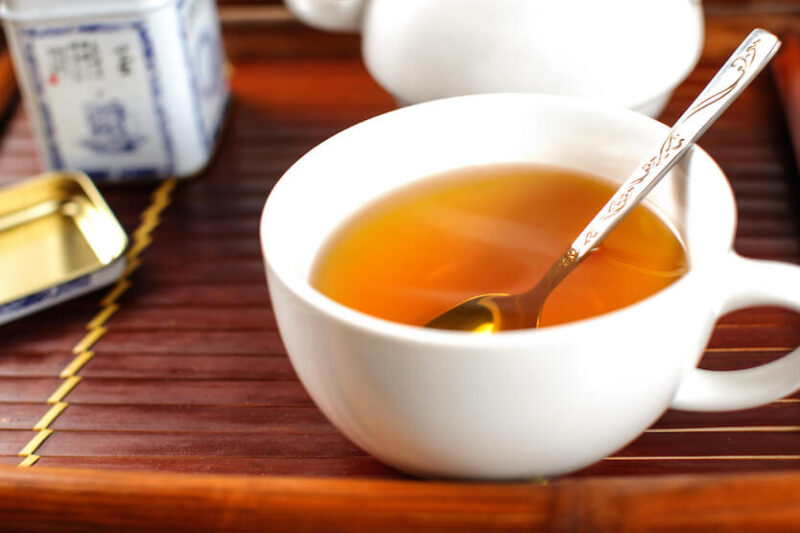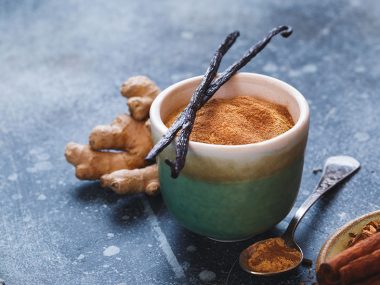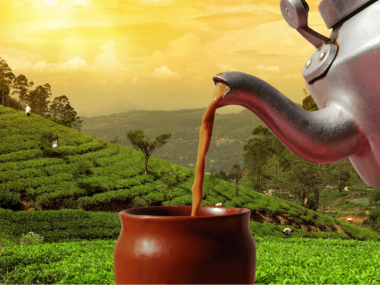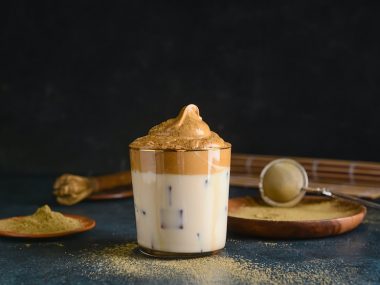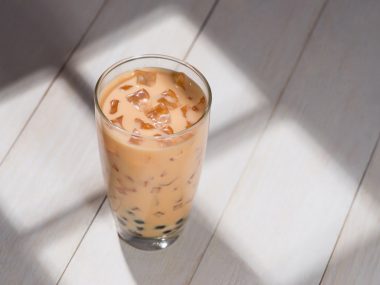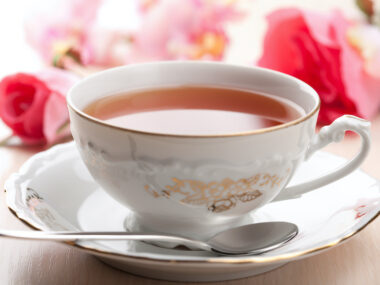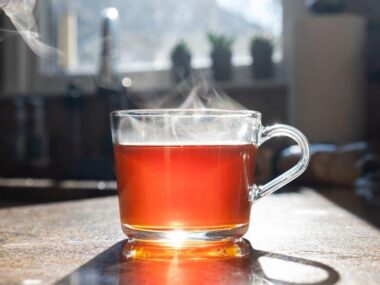If we told you that the foremost brand of tea in iced teas is made from something surprising, what would you say? Yes, your glass of iced tea is hiding a secret. This is incredibly mind-blowing if you think orange pekoe is a fruity tea.
Table of Contents
What is Orange Pekoe Tea?
Orange pekoe tea is a black tea that comes from the Camellia sinensis plant that is grown and harvested in India, Sri Lanka, Africa, Europe, Argentina, Indonesia, and Malaysia. The tea leaves from the tea plant are handpicked and processed into various blends of teas.
Does Orange Pekoe Tea Taste Like Orange?
The very thing that causes confusion and misconception about orange pekoe tea is its implied name, “orange.” This tea isn’t orange, nor does it taste remotely like orange or any other citrus. Are you surprised?
Orange pekoe tea is a black tea that has the essence and savor of black tea. So, how did this tea get its funky name that misleads us into thinking it has a fruity taste?
It’s believed that the misnomer ‘orange’ attached to pekoe resulted from Dutch tea traders who presented a Chinese tea to a Holland monarch. The tea that the traders bought from the Chinese was known as “baiho” (pek-ho, pekoe.) This tea was given to the “House of Orange” (Holland’s monarch.)
Orange Pekoe Starts With Black Tea
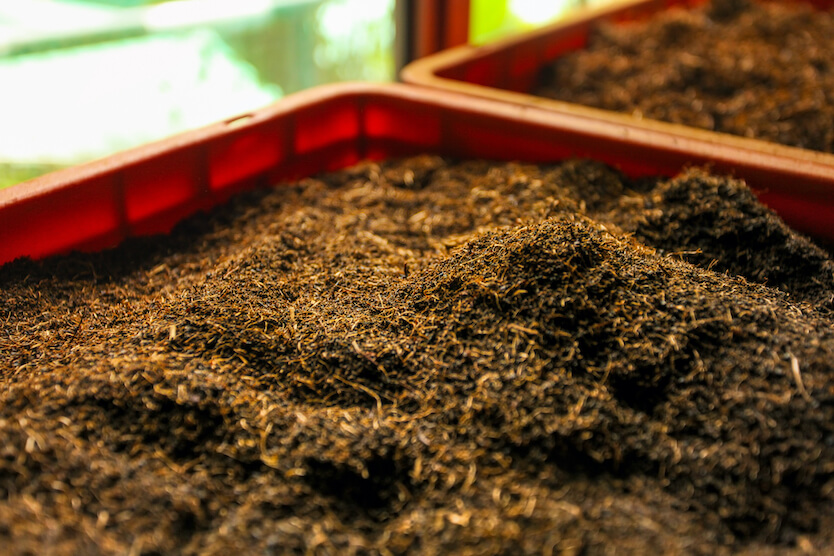
We are only going to explore black teas grown in countries other than China, Taiwan, and Japan. This is because of a grading system which we will cover further down.
Tea plants are grown in tea plantations. These plantations are located in a diverse range of climates. It’s the climates that contribute to the taste of the tea. For example, tea plantations in India may be located next to a lushly forested river at sea level or atop the steep sides of 6,000-foot mountains where the clouds skirt through and kiss each tea leaf.
Elevation plays such a big role in how the tea will taste. Teas grown at some of the highest elevations are most often premium tea. Lower elevation teas are often lower in quality. Factors like these affect how the tea is graded during processing.
How Black Tea Is Processed
Black tea begins with the tea plant. When that tea plant reaches a certain stage, it’s time to harvest the tea leaves. Harvesting is done in stages called “flushes.” A flush typically occurs 2-4 times a year from late winter/early spring to late summer/early autumn.
The tea’s flush is important because certain flushes also factor into whether a tea will be considered premium. But, more importantly, how the tea will taste. To give you an idea of flushes, we have included the below image.
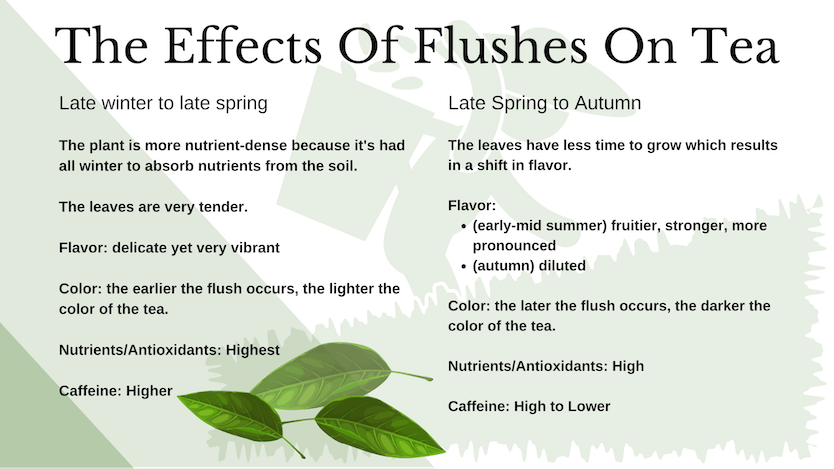
The handpicked tea leaves are taken back to the tea plantation’s processing area, where the leaves start their journey to becoming tea that we love and enjoy.
Withering
The green tea leaves, which were handpicked in a flush, are spread out in trays/troughs and left to go through a drying out period.
Rolling
The dried tea leaves are rolled by hand or a machine to cause rupturing of the leaf cells. This is important because it helps to speed up the fermentation of the tea leaf.
Sifting
Once the tea leaves complete the rolling process, they must be sifted. Large wicker/bamboo trays are filled with rolled tea leaves. The leaves are tossed into the air numerous times. This helps to sort out tea leaves that somehow didn’t get properly rolled.
Fermentation/Oxidation
After sifting and sorting, the tea leaves are taken to a room where they are spread out on a floor to undergo controlled oxidation.
Drying
Now the tea leaves are placed into drying tumblers where the last bit of moisture is removed.
Sorting and Grading
Sifting is once again required to further sort out small leaves from the bigger ones. After the final sifting, the leaves are graded based on their size. The bigger the leaf, the higher the grade. Higher graded leaves fetch a premium price.
Grading is something we want to dive further into because this is where orange pekoe comes into play.
Storing, Packing and Shipping
Now the tea leaves go to be stored, packaged, and shipped to tea manufacturers.
The Mystery Behind Orange Pekoe Revealed!
We finally get down to the nitty-gritty of what you’ve been waiting to find out more about. Are you ready to find out why orange pekoe tea got a name that’s misleading?
“Orange pekoe” is a term used to indicate the grade of a tea. If you pick up a tea that has “orange pekoe” included in the name or indicated somewhere on the packaging, you have a fine tea that’s considered premium. However, there’s a lot more behind “orange pekoe” grading, and we are about to open a door to a whole new world of graded teas.
Orange Pekoe Grading
Tea grading is how the tea industry prices various types of teas. There’s much more to picking up a box of teabags from the shelf of your local grocery store. To truly appreciate that glass of iced tea, it helps to have a better understanding of how that tea was graded.
We mentioned a “leading tea brand” used for iced tea earlier at the beginning of this article. Well, that brand of tea is made from orange pekoe. Yet another surprise revealed.
Understanding The Pekoe Grading System
Tea from countries other than China, Taiwan, and Japan goes through the pekoe grading. China and Japan have their own grading system, which is based on numbers and descending terminology.
For example:
- China: grades begin at 1 and go up. The higher the number, the lower the grade. The number “1” is considered the highest grade.
- Taiwan/Japan: the best tea is termed “extra choicest,” while a medium grade is “good, medium, good common,” and so on. There’s quite a bit that goes into their grading system.
Pekoe Grading
Whole leaf pekoe teas are graded based on whether it’s the whole leaf, broken leaf, fannings (bits of leaf,) or dust. The grading goes deeper to indicate if the tea contains buds. Specific abbreviations and terminology may vary among tea producers.
Below is an image that shows the various grades.
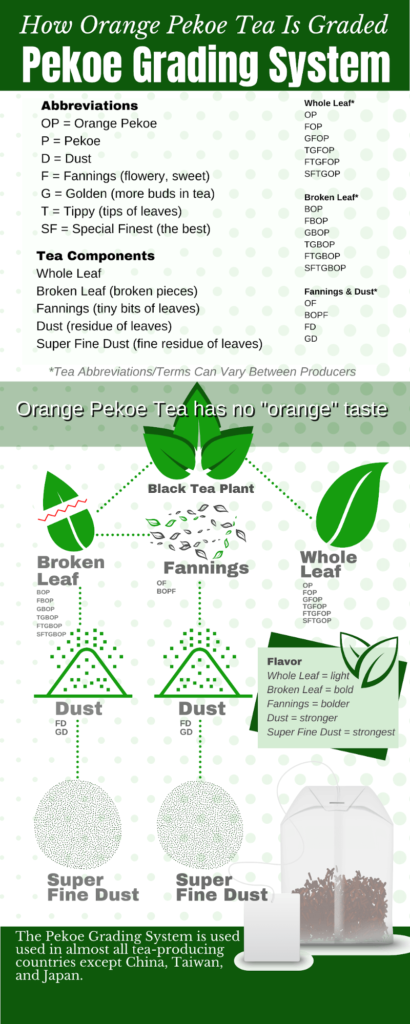
What Is The Difference Between Orange Pekoe and Black Tea?
Orange pekoe is a black tea grown in countries other than China, Taiwan, and Japan. The pekoe grading system isn’t recognized/used in those three countries because they have their own grading protocols. The only differentiation between orange pekoe and a black tea is if that black tea was grown in China, Taiwan, or Japan. The quality and flavor of black tea in those three countries may differ because of the different systems used to grade the tea.
How Much Caffeine Does Orange Pekoe Tea Have?
Orange pekoe is a black tea, and black teas contain the most caffeine. The amount of time you brew your tea greatly affects the caffeine level; the longer the brew, the higher the caffeine. A cup of orange pekoe tea can have up to 50 mg of caffeine.
- 1-minute brew: 14-19 mg caffeine
- 3-minute brew: 22-39 mg caffeine
- 5-minute brew: 27-49 mg caffeine
Is It Okay To Drink Orange Pekoe Tea Every Day?
Southern tea drinkers are great examples of how drinking orange pekoe tea daily is relatively fine. As long as you stay within the recommended daily intake of caffeine of 400 mg or less, you can enjoy orange pekoe every day. However, keep in mind that sweeteners and milk (for hot tea) can pack on the pounds if added to your tea.
Is Orange Pekoe Tea Good For You?
When we think of orange pekoe, we can’t help but think of the citrusy element of orange in the tea, which of course, has Vitamin C benefits. However, this tea is black tea with absolutely no orange in it. So, what is orange pekoe tea good for? We’ve listed a few benefits of drinking this tea.
Weight Loss
Our bodies contain a particular enzyme that’s responsible for how we metabolize things. The polyphenols in black tea activate that enzyme and help in controlling how much glucose and fatty acid our body stores. This is important when it comes to losing weight as our body will be encouraged to release stored fat and properly process glucose.
Improves Diabetes
Unsweetened black tea encourages our bodies to produce less glucose and helps us to metabolize sugars more efficiently. Insulin is something we as diabetics greatly rely on. Black tea helps our body to maintain better levels of insulin.
Antibacterial
Research showed that catechins and polyphenols in black tea are highly beneficial at fighting certain strains of bacteria. Pneumonia caused by Klebsiella and S. aureus is fought off by drinking black tea, as are Streptococcus mutans and Lactobacillus.
How to Drink Orange Pekoe Tea
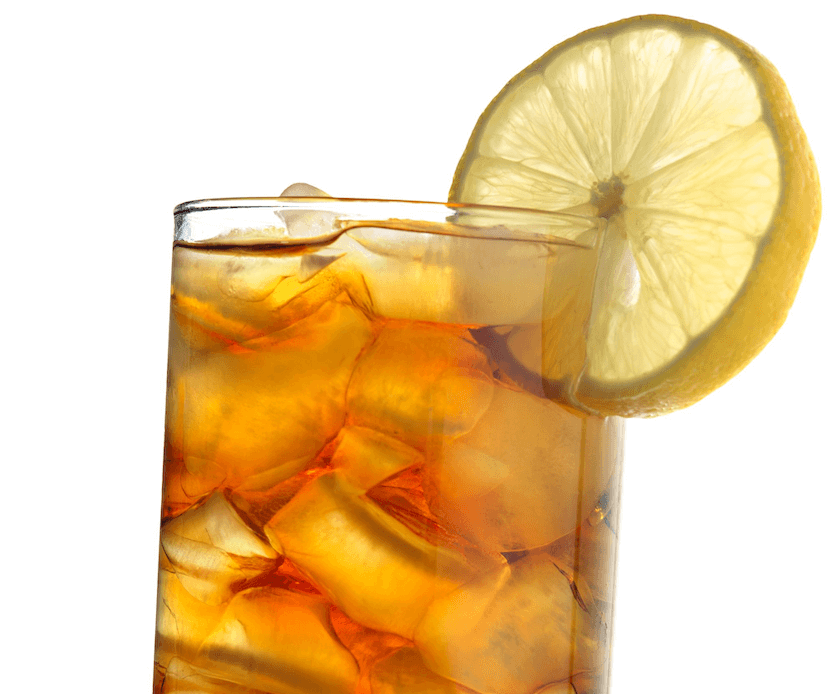
Orange pekoe tea can be enjoyed iced or warm. As with any other black teas, how you enjoy, it comes down to personal preference. Some may wonder, “Do you put milk in orange pekoe tea?” If you are accustomed to enjoying hot tea in British fashion, milk is in order then.
We have a few ways to prepare and enjoy orange pekoe tea.
Southern Sweet Tea
Ingredients
- 6-8 cups of water
- Orange pekoe tea (3 family size tea bags)
- ⅛ cup of honey (in place of sugar as a healthier alternative)
Directions
- Place water and tea bags into a pan and bring to a boil.
- Reduce heat and simmer for 5 minutes.
- Remove from heat and allow it to completely cool.
- Pour into a tea pitcher.
- Add honey and stir well.
- Pour tea over ice and enjoy!
“Orangey” Orange Pekoe Tea
Ingredients
- 2 cups of water
- 1 orange pekoe teabag
- Hefty pinch of fresh orange peel
- Honey (optional, to sweeten)
- Milk (optional)
Directions
- Bring water and orange peel to a boil.
- Remove from heat.
- Strain orange peel and discard.
Tip: Before pouring hot water into the teacup, use a little to bathe your teacup to warm it up. This helps a cold teacup to be more conducive to hot liquid.
- Place the tea bag into your teacup and cover to steep for 5 minutes.
- Add honey and milk if desired.
“Orange”: You Happy To Know The Truth Now?
All wit aside, we hope you learned something you didn’t already know about orange pekoe tea. The tea industry has a lot of background mechanics that not only go into growing and producing tea but grading it as well. “Orange pekoe” gives us the assurance we are getting a good product!
